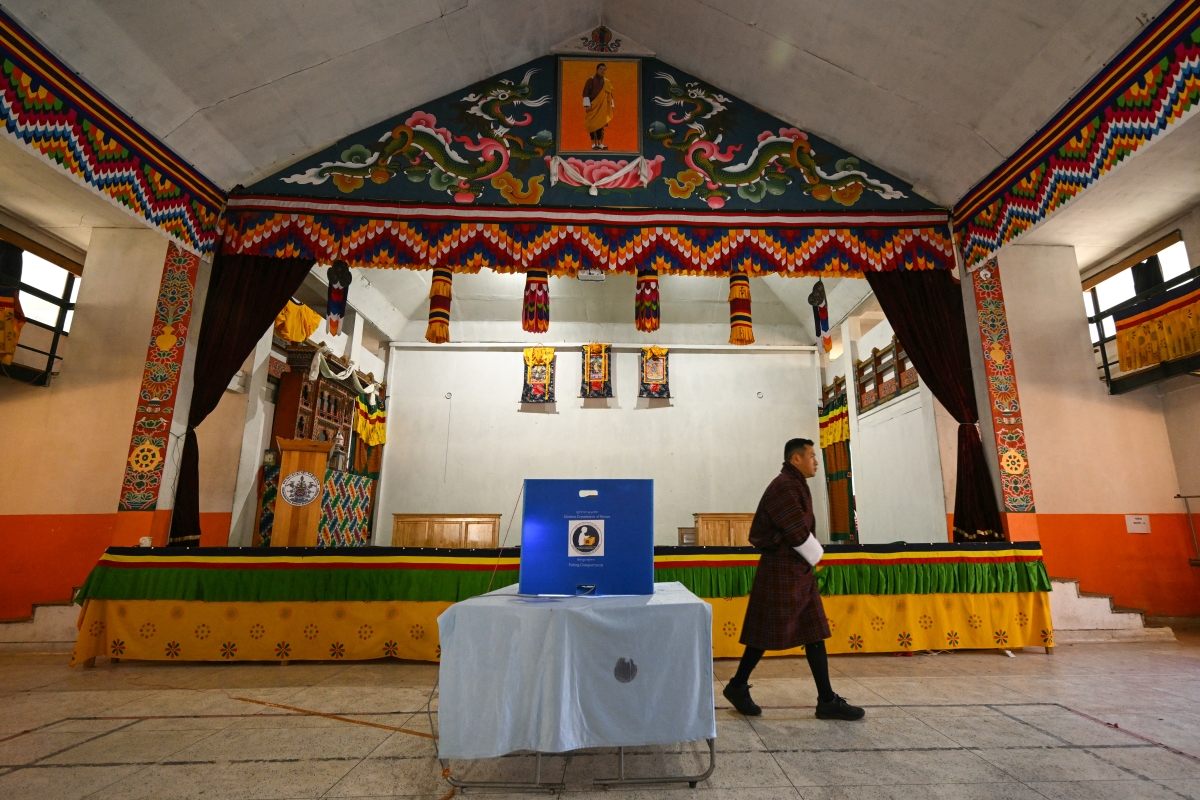Bhutan's 2024 Elections: Economic Complexities and Regional Dynamics

Bhutan, nestled in the Himalayas and the youngest democracy in South Asia, concluded its 4th National Assembly elections for 47 seats in 20 Demkhongs (zones) on January 9, 2024. The national elections were acknowledged as successful and mark Bhutan's unwavering commitment to democracy. Despite a voter turnout of 65.5%, slightly lower than for the 2018 elections, the event stands as a testament to Bhutan's distinctive democratic journey that began in the early 2000s. However, the recent casting of ballots brought attention to geopolitical shifts in the strategic Himalayan region, especially regarding Bhutan's proximity to a boundary agreement between neighboring giants, India and China.
Historical Context and Democratic Transition
Bhutan has consistently emerged as a model of democracy since 2008, standing in stark contrast to the challenges faced by democratic values in its neighborhood. The country’s journey toward democracy started with the King’s vision for Bhutan's modernization and democratization. However, the most pivotal catalyst for this transition was the global criticism surrounding Bhutan’s expulsion of the Lhotshampas — a minority group of ethnic Nepali speakers residing in southern Bhutan.
Bhutan justified the expulsion of the Lhotshampas, who had predominantly settled in refugee camps in eastern Nepal, as a measure to preserve the national cultural identity. However, this action sparked hostility in Nepal, given its cultural proximity to the Lhotshampas. Concerns arose that the Maoists, actively opposing the monarchy in Nepal, could potentially arm the Lhotshampas, thereby leading to unrest in Bhutan. In response to these challenges, the monarchy promptly implemented a political transition with the goal of reassuring critics that human rights were now ensured under the provisions of the new constitution.
In 2007, the UNHCR and the International Organization for Migration (IOM) collaborated on an initiative with the goal of resettling more than 100,000 Lhotshampa refugees from Nepal to various countries, including but not limited to Australia, Canada, the United Kingdom, and the United States. Despite these efforts, several individuals continue to reside in refugee camps, holding onto the hope of eventually returning home one day.
Election Outcomes and Political Landscape
Among the five contesting parties — People’s Democratic Party (PDP), Druk Phuensum Tshogpa (DPT), Druk Nyamrup Tshogpa (DNT), Druk Thuendrel Tshogpa (DTT), and Bhutan Tendrel Party (BTP) — only the PDP and BTP advanced to the General Round held on January 9. The PDP secured victory with 30 seats, led by Tshering Tobgay, a Harvard-educated former civil servant and Bhutan’s second prime minister from 2013 to 2018. In spite of shared campaign goals of economic revival and maintaining the rule of law, PDP's solid track record of advancing economic growth and political experience provided an edge over the newly founded BTP.
International Responses and Regional Dynamics
The international community, including both the United States and India, has commended Bhutan for the successful and peaceful conduct of its elections. Both nations have expressed a keen interest in collaborating with the new government to strengthen friendly relations. India, particularly aware of the geostrategic implications, is eager to foster a close working relationship with the new Bhutanese government.
Bhutan holds a pivotal role in navigating the strategic Himalayas for India, especially in monitoring Chinese activities in the Dhoklam area — a trijunction involving India, Bhutan, and China, where the 2017 standoff between the Chinese People’s Liberation Army (PLA) and the Indian Army occurred. Despite the enduring friendship between India and Bhutan, there is apprehension regarding the ongoing border settlement with China. India is concerned that the Dhoklam region might be ceded to China, potentially giving Beijing control of the critical Siliguri Corridor — a narrow stretch connecting India’s eight north-eastern states of India, including Arunachal Pradesh, to the rest of the country. Furthermore, Chinese construction activities along the China-Bhutan border raise worries about a potential push by the PLA through Bhutanese territories into India.
As the prospect of diplomatic ties between Bhutan and China looms, the long-standing influence of India on Bhutan's foreign and security affairs is now facing a credible challenge, prompting India’s desire to collaborate closely with the new Bhutanese leadership to safeguard its strategic interests.
Beyond the immediate region, the United States, though a distant observer, closely monitors Bhutan's boundary discussions with China, recognizing their potential regional implications. Bhutan, currently lacking diplomatic ties with any of the permanent members of the Security Council — China, France, Russia, the UK, and the United States — could attract heightened U.S. interest if it engages with China. The United States is likely to seek a presence in Bhutan to promote stability and address shared concerns in the broader regional context.
Challenges and Imperatives Facing Bhutan's Development
Despite Bhutan's commendable progress in health, education, and infrastructure during its 15-year democratic journey, there is a pressing concern about the translation of these efforts into tangible economic advancements and the effective resolution of youth unemployment. The 2019 United Nations Development Programme report recognizes Bhutan's achievements in human development, but economic challenges persist.
The focal points of the 2024 elections underscore the critical issues of youth unemployment, economic growth, a shrinking private sector, poverty, migration, brain drain, and a declining fertility rate. Notably, Bhutan's youth unemployment surged from 20.9% in 2021 to 28.9% in 2022. Both the PDP and the BTP have presented similar manifestos, pledging to address these concerns, particularly the alarming trend of skilled professionals migrating abroad. In the past year alone, almost 15,000 Bhutanese individuals, including professionals and skilled individuals, left the country, placing a strain on public service delivery in essential institutions such as hospitals and schools.
On the economic front, Bhutan is grappling with a meltdown, characterized by a dismal average growth rate of 1.7% over the past five years — the lowest in recent history. The private sector, a crucial pillar of the economy, is experiencing stagnation, with businesses operating at reduced capacity or shutting down. There has also been a concerning surge in poverty within the country.
Navigating the Path Forward
The new government, in its immediate messaging, welcomes businesses to Bhutan but faces the intricate task of balancing economic growth with sustainability, in alignment with the unique philosophy of “Gross National Happiness.” This requires forging partnerships, fostering innovation, and prioritizing private sector participation while safeguarding Bhutan’s distinctive ethos.
The PDP government is tasked with economic recovery, employment generation, wealth disparity reduction, agricultural revitalization, and strengthening educational and medical institutions. Mitigating brain drain remains a priority, emphasizing the importance of a robust service sector.
Simultaneously, Bhutan must adeptly navigate its boundary dispute with China to ensure a smooth resolution that does not raise concerns in Delhi. Given India’s security interests tied to Bhutan’s geographical position vis-à-vis China, Bhutan’s strategic decisions in engaging with China will have far-reaching implications for the strategic Himalayas, influencing regional dynamics for India and major world powers.

